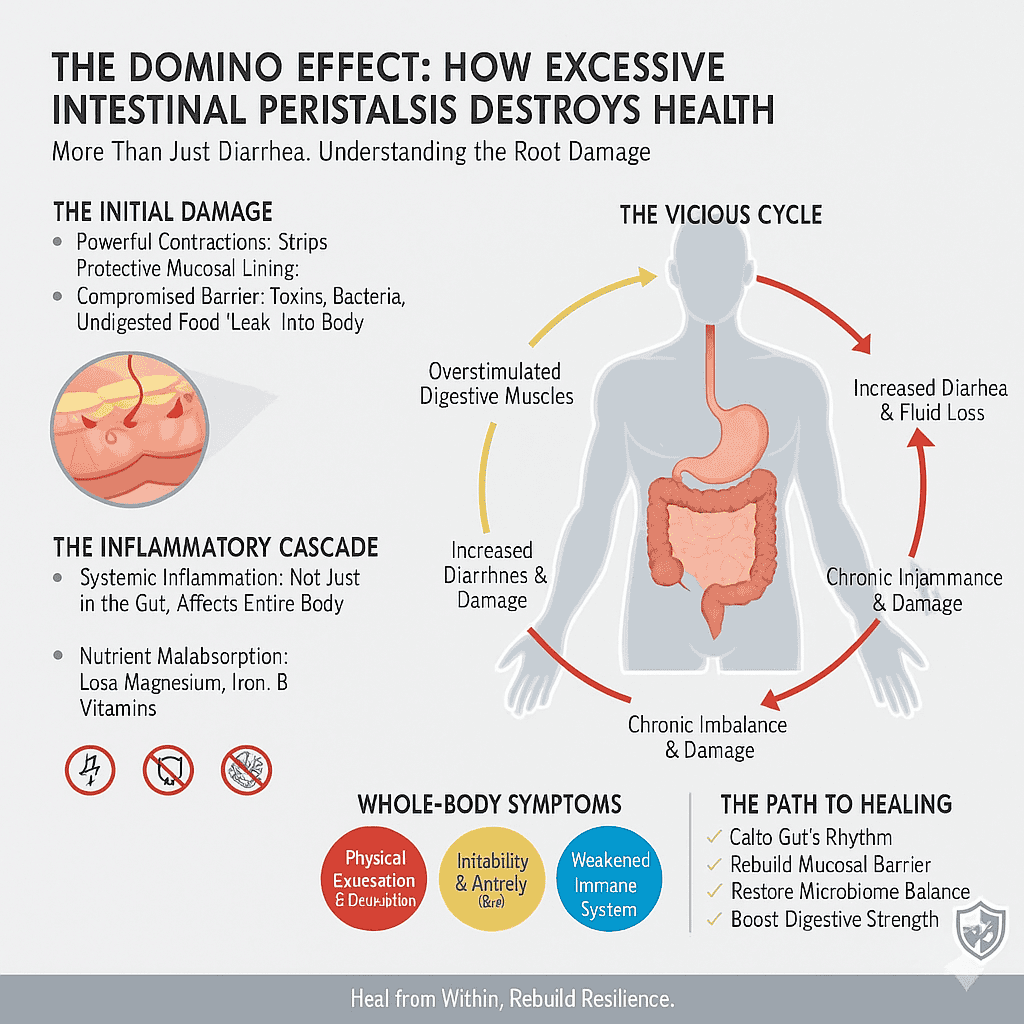Excessive Intestinal Peristalsis: Causes, Symptoms, and Chronic Diarrhea Management Guide
Ever wondered why some days your stomach seems to twist and churn uncontrollably, leaving you running for the bathroom again and again? That’s the hidden havoc of excessive intestinal peristalsis, a condition which occurs when your gut muscles contract too quickly and too forcefully. What feels like “just diarrhea” is actually your body’s distress signal, showing that something deeper is off balance. Left unchecked, it can tear down your gut lining, block nutrient absorption, and drain your energy.
But here’s the good news: with the right understanding and a few smart steps toward chronic diarrhea management, you can calm your overactive gut, rebuild your intestinal health, and reclaim lasting comfort.
Why Excessive Intestinal Peristalsis Damages Your Health
Think of your gut as the root system that sustains your entire body. When excessive intestinal peristalsis sets in, those roots are altered of their functions. The intense, rapid contractions don’t just move food along — they strip away the protective mucosal lining of your intestines. Without that barrier, harmful bacteria, toxins, and undigested food particles seep through the gut wall, igniting inflammation that can extend far beyond your digestive system.
This chain of reactions leads to more than just discomfort. Your body begins losing essential nutrients like magnesium, iron, and B vitamins, which are crucial for energy, immunity, and mental clarity. Over time, you may feel drained, irritable, or even anxious — not realizing your gut’s instability is at the core of it all.

Left unaddressed, this cycle can evolve into a chronic state of imbalance where your digestive muscles are constantly overstimulated, leaving you dehydrated and nutritionally depleted. That’s why effective chronic diarrhea management goes beyond stopping loose stools — it focuses on calming your gut’s rhythm, rebuilding the mucosal barrier, and restoring balance to your microbiome.
Strengthening your digestive power plays a key role in this recovery process, and learning how to naturally boost your digestive strength for better gut function can help you rebuild resilience from within. By understanding how excessive intestinal peristalsis damages not just your gut but your entire body’s vitality, you can take the first real step toward healing — one that begins deep within and promotes lasting digestive harmony.
Before jumping into solutions, it’s important to understand what triggers this cycle in the first place. Learning the underlying causes and the basics of chronic diarrhea management can help you take control of your gut health and prevent flare-ups from returning.
3 Root Causes of Excessive Intestinal Peristalsis
Understanding the triggers is the first step toward healing. Here are the primary drivers of chronic gut overactivity.
1. Bacterial Overgrowth and Toxin Irritation
When waste stagnates in the colon, it becomes a breeding ground for harmful bacteria. These pathogens produce potent fecal toxins that severely irritate the colon’s lining. In response, the tubular glands secrete excessive fluid to flush out the irritants, triggering debilitating diarrhea and rapidly depleting your body’s essential resources.
2. Undigested Food Particles and Inflammation
For many individuals, certain compounds like FODMAPs (Fermentable Oligo-, Di-, Mono-saccharides, and Polyols) and gluten are difficult to digest. When these particles remain intact, they scrape and inflame the sensitive intestinal lining. Your body then initiates rapid bowel movements as a defense mechanism to expel the perceived threat, leading to acute or chronic diarrhea.
3. Villi Damage and Nutrient Malabsorption
The villi are millions of delicate, finger-like projections in your small intestine responsible for absorbing nutrients. Persistent inflammation from chronic diarrhea flattens and destroys these villi. This damage severely cripples your ability to absorb vitamins and minerals, directly leading to malnutrition, energy crashes, and a compromised immune system, even if you eat a healthy diet.
Your 5-Step Protocol to Stop Gut Overactivity and Promote Healing
Restoring balance requires a layered approach that addresses both immediate relief and long-term repair.
1. Achieve Immediate Symptom Relief
During an acute flare-up, prioritize rest and hydration. Consequently, follow a bland diet (e.g., BRAT diet) and sip on electrolyte-rich fluids. This crucial step gives your overworked muscles a chance to rest without further irritation.
2. Repair Damaged Villi and the Gut Lining
To heal, your body needs specific building blocks. Incorporate gut-supportive nutrients like L-Glutamine (an amino acid that fuels intestinal cells), Zinc Carnosine (known to repair the gut lining), and demulcent herbs like Slippery Elm. Bone broth is another excellent source of collagen and minerals that support mucosal repair.
3. Restore a Healthy Microbial Balance
Harmful bacteria often drive gut irritation. Therefore, you must reintroduce beneficial bacteria to crowd out pathogens. Take a high-quality, multi-strain probiotic and incorporate traditionally fermented foods like kefir, sauerkraut, and kimchi into your diet to restore a healthy microbiome.
4. Identify and Eliminate Dietary Triggers
Chronic issues require your detective work. Implement a strict elimination diet to identify sensitivities to common irritants like gluten, dairy, soy, and high-FODMAP foods. By removing these triggers, you reduce the inflammation that causes excessive intestinal peristalsis — a crucial step in long-term chronic diarrhea management and gut healing. Explore more on diet from our blog for healthy diet choices.
5. Maintain Long-Term Intestinal Cleanliness
Finally, prevent the buildup of toxic waste. Support regular, healthy bowel movements (1-3 per day) with a high-fiber diet rich in vegetables and adequate water intake. This practice ensures toxins don’t accumulate and restart the cycle of irritation.
Frequently Asked Questions About Excessive Intestinal Peristalsis
Can chronic diarrhea cause permanent damage to my intestines?
Yes, prolonged episodes can indeed erode and flatten the intestinal villi. This damage impairs nutrient absorption, potentially leading to long-term malnutrition and related health complications if left unaddressed.
How long does it take for intestinal villi to heal after excessive intestinal peristalsis?
Healing time varies significantly based on the severity of the damage, your age, and dietary compliance. However, with a strict protocol focused on removing irritants and providing healing nutrients, many people see significant improvement within several weeks to a few months.
What is the single most important step I can take for my gut health?
While comprehensive care is best, maintaining intestinal cleanliness through regular bowel movements is paramount. This prevents the bacterial overgrowth and toxin production that are primary drivers of excessive intestinal peristalsis and gut lining irritation.
What natural approaches support chronic diarrhea management?
Effective chronic diarrhea management includes staying hydrated, avoiding irritants like gluten and lactose, and replenishing beneficial bacteria with probiotics. Simple lifestyle changes — such as stress reduction, regular meals, and adequate sleep — also help restore a calm, balanced intestinal rhythm.
